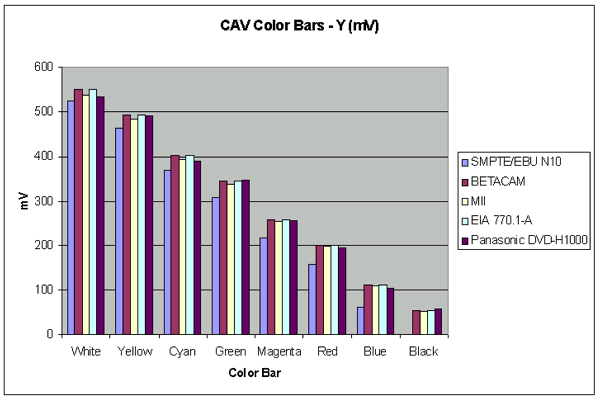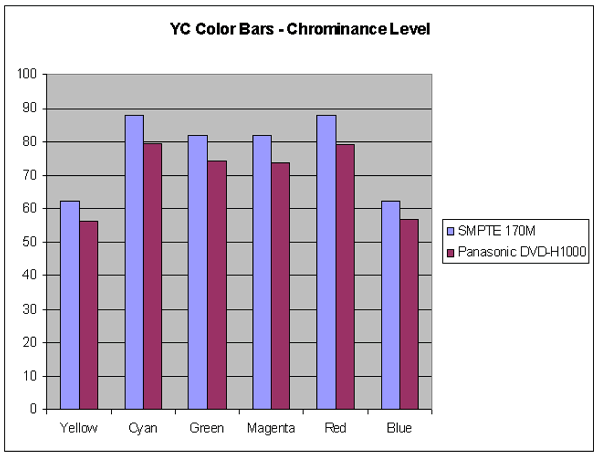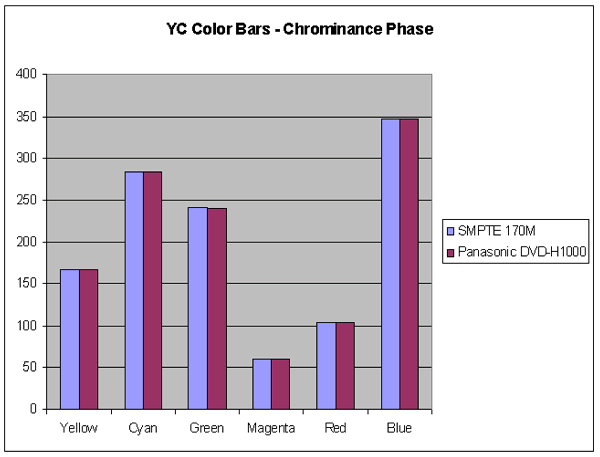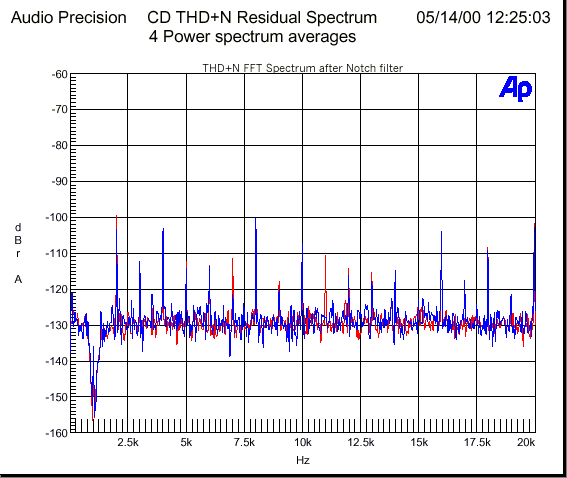Staff
![]()
Background
Panasonic is huge in the consumer electronics area. If you don�t like the product they released this month, wait another month and a newer version will be out. The Panasonic DVD-H1000, like the A310, is one of the most usable players we tested. The fortunate thing about being a huge, wealthy company is being able to quickly revise your players to address market conditions. Panasonic recognizes the importance of the remote for the overall DVD experience.
By now, you probably wonder why we tested older
players. The main reason is that no other magazine has ever gathered the
depth of information we have done here, and we want to be able to see how
new players have improved. As you have seen, some new models are not as good
as their previous models, and thus, you could probably get one of the older
players for a song.
The DVD-H1000 was one of the very first high-end progressive DVD players. It is
also the first one guilty of marketing 4:4:4 processing. While we mentioned this in part 1,
we are going to say it again right now: ALL DVD
players output 4:4:4 from the CAV outputs. Panasonic might as well
have advertised that their DVD player can in fact play DVDs. Sony
tried a similar tactic when they launched the DVP-S7000. They
mentioned that it used 10-bit video DACs. Toshiba had already been
using 10-bit DACs, but they just never advertised it.
Anyway, here are our test results:
Video
The video quality of this DVD player is very good to excellent.
The CAV outputs are properly labeled Y�Pb�Pr�, but they use the inferior RCA connectors.
Black and White Levels
| Format | Black | White | Comments |
| CAV | 7.8 | 98.1 | The black level is 0.2 IRE high. White is 1.9 IRE low, but it is really very close. |
| YC | 7.6 | 99.4 | The YC levels closely match the CAV levels. |
Color Bars
CAV
The Y portion of the signal does not want to be consistent from black to white. At white, it falls below MII and above SMPTE. When it gets to yellow, it almost matches Betacam� and EIA 770.1. When it gets to green, it's hotter than all of the levels. You can look at the graph below to see what is happening.
Pb is consistent from yellow to blue. In all cases, it's slightly low, falling just below MII. Pr is consistent from yellow to blue just like Pb (this is a good thing). In all cases, it's slightly low, falling just below MII.
Component Analog Video Data



YC
The Y portion of the YC output is just a hair below SMPTE 170M. Unlike the CAV output, the YC Y is consistent from black to white.
The chroma level is low, but is consistent from yellow to blue. You will probably need to turn up the color on your TV when using this player. The chroma phase is perfect, and you should not need to adjust the tint control on your TV if it is following SMPTE 170M.
Composite/YC Data



Video Frequency Response
The video frequency response is very interesting on this player. Since there are four levels of detail control, you should try "Off" to start with, and maybe "Detail 1". Anything else just adds too much ringing to the image. The graph below results from setting it at "Detail 1".
You can see that the frequency response goes above 0 dB and stays there until around 4 MHz. This shows up as ringing in the picture. Even though the frequency response peaks, its ringing is nowhere near as severe or even as annoying as with the Pioneer DV-09. We suspect this player has MUCH better video filters. There is a fair amount of roll-off at 5 MHz.
There is a noticeable amount of ringing when looking at the Avia sharpness pattern. However, there is less ringing than with any of the Toshibas or Pioneers. On the other hand, there is more ringing than with the Sony's, Proceed, and Meridian.
Video Frequency Response

Pixel Cropping
Standard Mode:
| Location | Pixels | Comments |
| Top | 3 | Good |
| Bottom | 4 | Good |
| Left | 14 | Poor |
| Right | 14 | Poor |
4:3 Mode:
This mode is only used on 16x9 TVs that force you into full mode when it detects a progressive source. You would use this on Pioneer and Mitsubishi TVs. You will not need this on a Toshiba TV.
| Location | Pixels | Comments |
| Top | 3 | Good |
| Bottom | 4 | Good |
| Left | 25 | Very Poor |
| Right | 30 | Very Poor |
Signal-To-Noise Ratio
| Format | Output | SNR (dB) | Comments |
| CAV | Y | -70.8 | Excellent |
| CAV | Pb | -73.2 | Excellent |
| CAV | Pr | -73.6 | Excellent |
| YC | C-AM | -65.7 | Very Good |
| YC | C-PM | -63.5 | Good |
Component Channel Timing
| Channel | Timing (ns) | Comments |
| 'Pb' to Y | -0.4 | Stellar |
| 'Pr' to Y | -1.6 | Excellent |
| 'Pb' to 'Pr' | 1.2 | Excellent |
Audio
Audio Frequency Response
Audio frequency response on the DVD-H1000 was terrific. Like the A310, it is not quite as extended as the flattest in terms of high frequency response, but very close, and with the nice, smooth taper we look for. From 20 Hz to 5 kHz, the plotted response hugged the 0 dB line without fault.
Audio Frequency Response

Harmonic Distortion + Noise FFT
Although the DVD-H1000 lacked the 7.5 kHz anomaly that plagued the Panasonic A-310, and even though the total amount of distortion was relatively low, the spectrum was a bit disappointing from a technical perspective, showing higher order distortion products as high or even higher than lower order distortion products. Granted, all of them were �100 dB down, but considering the distortion spectrum of Panasonic's A310, we were hoping that the performance would match, without the 7.5 and 15 kHz spikes that came with the A310.
Distortion Spectrum

Wide-Band noise spectrum FFT (Wall AC)
The noise spectrum with the unit plugged into the wall is actually pretty decent. The highest peak is at 60 Hz, but still at �103 dB below full scale output, with power-line harmonics at 180 Hz and 240 Hz predominantly, both below �115 dB.
Noise Floor (Wall)
.gif)
Wide-Band noise spectrum FFT (Lab grade AC)
Given a clean AC source via the Power Plant P300, the noise spectrum improved, pulling the peak at 60 Hz down to �120 dB, and the power-line harmonics at 180 Hz and 240 Hz to below �127 dB.
Noise Floor (Lab)
.gif)
Low-Level DAC Linearity
Low-level linearity from the D/A converters was excellent, with response that stayed within 1 dB of linear down to �107dB, and it might have kept going if not for the 16 bit test signal. We have to say, in this parameter, the DVD-H1000 was spectacular.
DAC Linearity

Dynamic Range
97.7 dB. Go figure, better than 16-bit with a 16-bit source. Very competent.
Inter-Modulation Distortion
-114.4 dB, very good.
Functionality
Note: A green check in the boxes below means that feature worked OK. A red X means it is unsatisfactory.
Avia
| Test | Results | Comments |
| Subpicture |
|
|
| Slide Show |
|
Video Essentials
| Test | Results | Comments |
| Blacker-Than-Black |
|
|
| Stress Test |
|
WHQL
Subpicture Palette (DCS)
| Test | Results | Comments |
| Still |
|
|
| Bob |
|
|
| Weave |
|
Default Palette Color Index
| Test | Results | Comments |
| Still |
|
|
| Bob |
|
|
| Weave |
|
Custom Palette Color Index
| Test | Results | Comments |
| Still |
|
|
| Bob |
|
|
| Weave |
|
Branching
| Test | Results | Comments |
| Seamless Branching |
|
This player performs as it should, by taking 2 sweeps to branch. |
| Multiple Angles |
|
This player takes about 1 second to change angles. |
Menu
| Test | Results | Comments |
| Loops |
|
|
| Ends |
|
Field/Frame Freeze
| Test | Results | Comments |
| Weave |
|
Can't Pause |
| Bob |
|
Can't Pause |
16x9 Menu
| Test | Results | Comments |
| Letterbox |
|
|
| Widescreen |
|
Cropping
| Test | Results | Comments |
| 352x240 |
|
|
| 720x480 |
|
|
| 704x480 | ||
| 352x480 |
Layer Break
It takes about 1 second to change layers.
| Test (DVD) | Results | Comments |
| "Cruel Intentions" |
|
|
| "Ghostbusters" |
|
|
| "Friends" VCD | OK, but we found that if you are using the progressive outputs, you must set to forced video mode or you get severe feathering. | |
| "Saving Private Ryan" (DTS) | ||
| "The Abyss" | ||
| Chesky Super Audio 96/24 | You can select 96 kHz or down converted to 48 kHz on the digital output. |
Physical Response
This player falls on the slower half of the scale. We gave it a 4.
| Test | Results | Comments |
| Setup |
|
|
| Transcode |
|
|
| CD-R |
Error Correction/Concealment
Pierre Vareny
This player can play up to and including track 31, which represents a 1.00mm gap.
Scratch the Dog
This player becomes pixilated at chapter 2 and eventually dies at chapter 5.
Usability
The usability of this DVD player was identical to the A310.
The Remote Score = 9 out of 11. The images shown below give you an indication how the Panasonic designers have considered the usability of the remote.


We established our rating scheme in the usability article with the Eleven Tenets of Remote Design. Each one of those principles gets the player 1 point, so the maximum possible score would be 11. See the comments for each of those design tenets.
| Test | Results | Comments |
| Button Access |
|
The buttons are well separated and are easily depressed without accidentally hitting other buttons. This is not a proper universal remote, but it combines the two most important devices for DVD viewing: the TV and the player. |
| Minimal number of buttons |
|
As you can see in the photos, the Panasonic remote has a sliding panel to conceal the less frequently used features and number pad. |
| Distinctive buttons | The buttons have very unique shapes are well spaced. This makes the remote effortless to use in the dark. One of the tasks we had users perform was pausing the movie, putting the remote down, picking it back up, and resuming without looking at the remote. Users could more readily do this with the Panasonic than with any other brand. The arrow keys are integrated with the Select key in the middle of the remote, which is a clever use of space. | |
| Appropriately sized buttons | Many remotes have to decrease the size of their buttons to fit everything in. This remote makes the more frequently used buttons larger. | |
|
Good tactile feedback |
The buttons provide a good feel when depressed, and the Select function on the center �joystick� provides a distinct click. When combining buttons in this fashion, it is important to make it difficult to accidentally press Select while moving the cursor. They did a great job here. | |
|
Fits well in a single hand |
The remote controls are clustered at the top of the unit so that they can be easily accessed by an average sized hand�s thumb. The only time you must use two hands is perhaps when you are changing the TV channel/volume or using the buttons under the sliding panel. | |
| Right/Left Handed | The remote is relatively slender, making it easy for people with small hands. | |
| Backlighting | There is no backlighting. This feature is especially useful when you are using the less important buttons (like Audio, Angle, and Subtitle). It drains batteries quickly, but rechargeable batteries are inexpensive. | |
|
Indication of control mode |
This isn�t really a universal remote, although we are curious how the television knows we are pressing channel numbers vs. DVD chapter numbers. | |
|
Standard naming |
The buttons are consistently named. | |
|
Player feedback |
This player gets credit for feedback because it provides at least something to indicate when you are attempting forbidden operations. In fact, most players have a problem with error messages. When you cannot perform a certain function (for example, hitting the menu key when the disc is playing), they have one of three messages. (1) "This operation not permitted now�, (2) a circle with a line through it, or (3) nothing at all (this is particularly inexcusable IMHO). The Panasonic player uses the second of these informative messages. I can understand why they use a symbol: it is one less text string that they need to translate for foreign markets. However, it would make the user experience so much smoother to provide a short text string saying why it isn�t available and how to make it available. In this case, a short message like �Please press Stop before pressing the Menu button.� |
The Bottom Line
This player rates as one of the more easily configured and used players. Panasonic did a great job designing this product for ease of use.
Progressive
Film
| Test | Comments |
| Basic | OK |
| Alternate | OK |
Video
| Comments |
| OK |
Speed
| Comments |
| OK |
Discontinuity
| Test | Comments |
| Basic X | Overall frequent dropping into Bob mode. Right hand wedge has intermittent short scintillations. As in the video port speed tests, left hand wedge tip is corrupted with scintillation and "dot crawl" moir� pattern, from the 475-line point. Periodically shows feathering and shredding. |
| Alt Y | Noticeably spastic, with jerks in overall motion and very brief shredding. |
| Alt 1 | Worse than X, more displacement and shredding on the 3:3 hits. |
| Alt 2 | Slightly better than alt 1 but still bad. |
Mixed Mode
| Test | Comments |
| Basic Y | Works very well (even the little blue light was on when it was supposed to be. This is the film mode light.) |
| Alt X | Works very well, slight jerk forward on some bob to weave transitions. |
| Alt 2 | OK |
| Alt 1 | OK |
Chapter Breaks
| Test | Comments |
| Alt 1 | OK |
| Alt 2 | Two successes out of four tries. |
- Staff -
| DVD Benchmark Explanatory Articles | |||
| Part 3 - Functionality | Part 4 - Usability | Part 5 - Progressive Scan |
Return to Table of Contents for this Issue.

